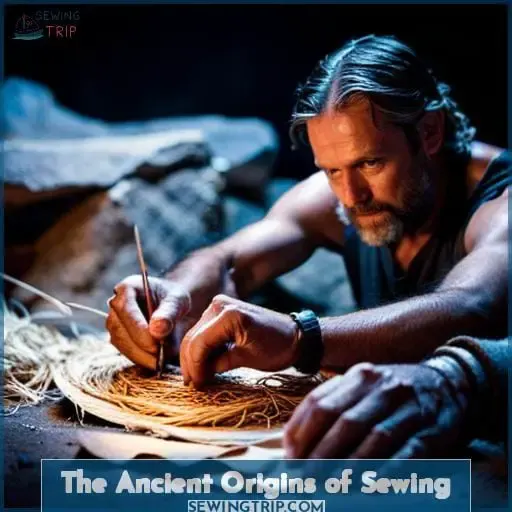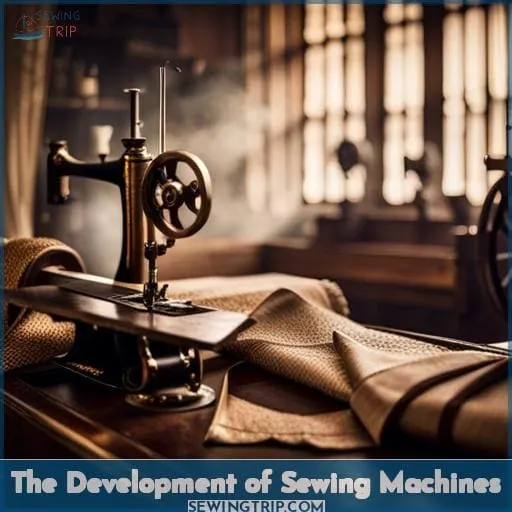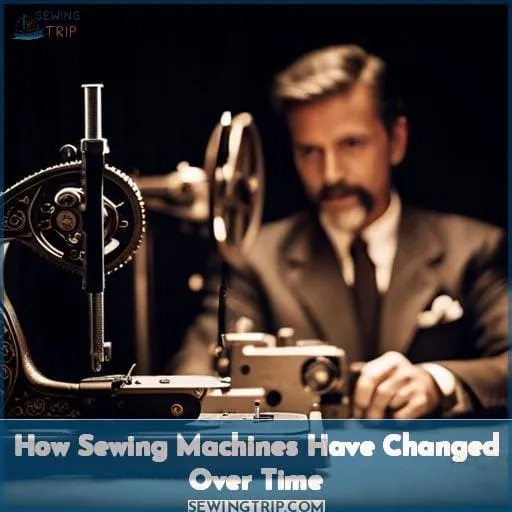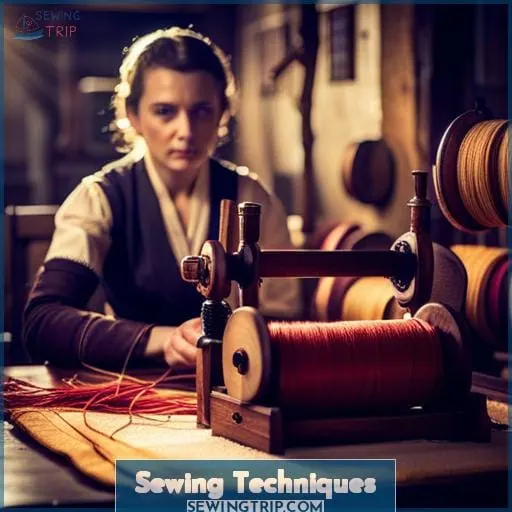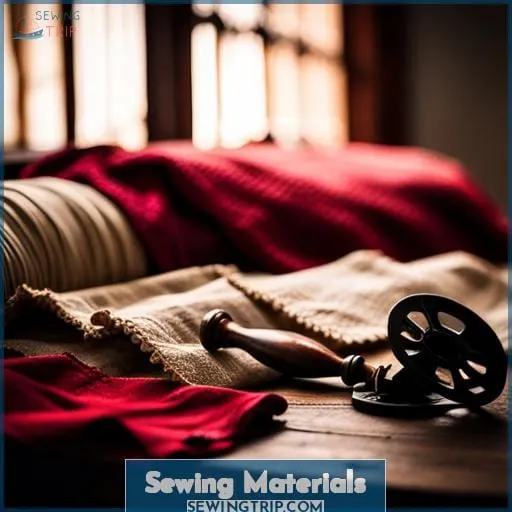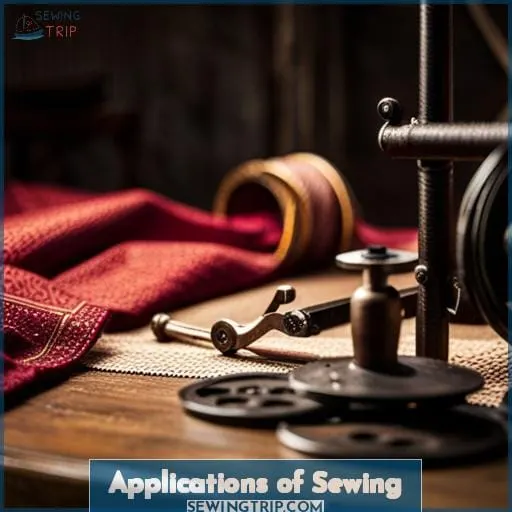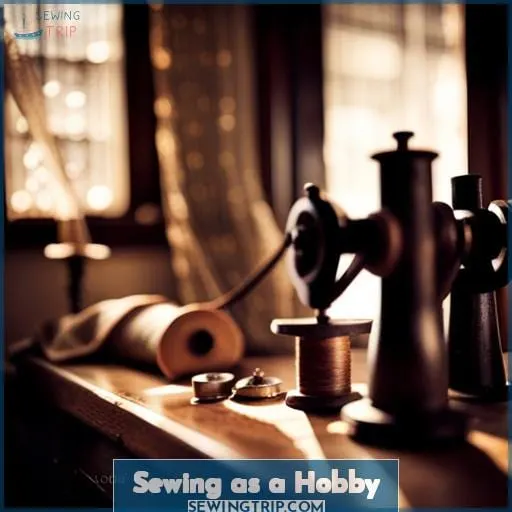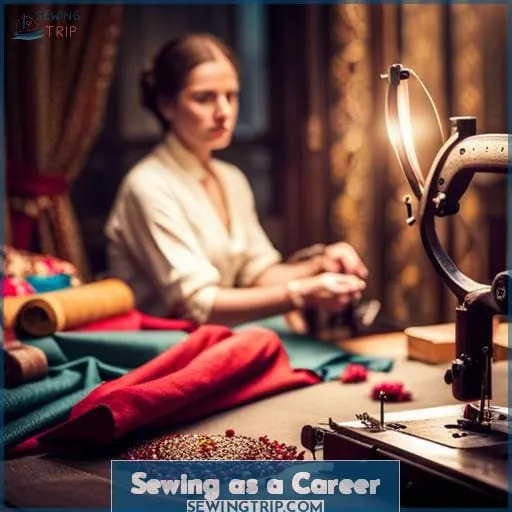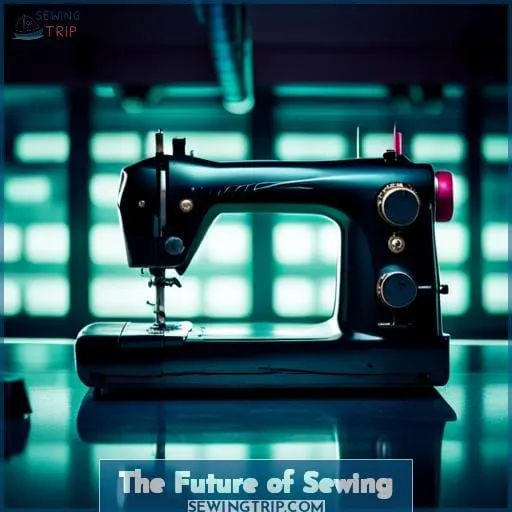This site is supported by our readers. We may earn a commission, at no cost to you, if you purchase through links.
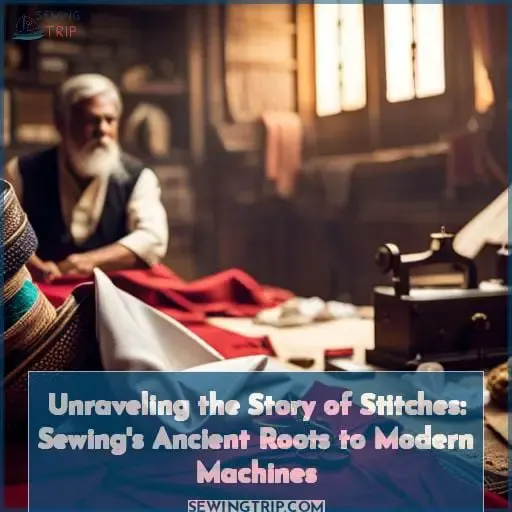 Stitching, an art form that weaves together fabrics and cultures, has a remarkable history spanning thousands of years.
Stitching, an art form that weaves together fabrics and cultures, has a remarkable history spanning thousands of years.
Join us as we unravel the story of sewing, from its ancient origins to the modern marvels of computerized machines.
Discover how this craft, born from necessity, transformed into a symbol of creativity and expression.
Prepare to be captivated by the evolution of sewing, a journey that binds humanity through time.
Table Of Contents
Key Takeaways
- Sewing emerged in the Paleolithic era, with animal skins, fur, and bark serving as fabric and animal bones or antlers as needles.
- Primitive stitching techniques evolved into intricate textiles, leading to the invention of the wooden machine in the 14th century, which introduced a chain stitch.
- Elias Howe’s 1846 patent for a practical sewing machine revolutionized the industry with its lockstitch design, automatic feed, and under-fabric shuttle.
- Future sewing innovations include sustainability trends, AI integration, community workshops, and online platforms, making sewing more accessible, sustainable, and technologically advanced.
When Was Sewing Invented?
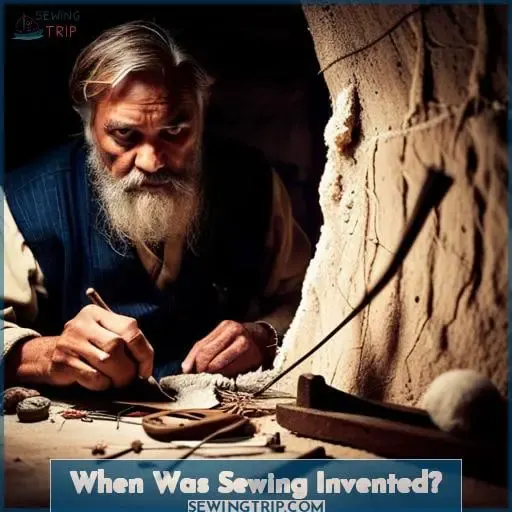
How far back does the history of sewing go, and when did it all begin?
Sewing’s roots trace back to the Paleolithic era, where early humans utilized materials like skin, fur, and bark to create rudimentary garments and tools. Needles crafted from animal bones or antlers, along with thread made from animal tendons or veins, served as the primary tools for joining these materials together.
In the 1830s, Barthélemy Thimonnier, a French inventor, revolutionized sewing with his invention of the first sewing machine. Though it formed a chain stitch using a single barbed needle and thread, its results resembled hand sewing and were prone to snags.
Elias Howe’s 1846 patent for a practical sewing machine marked a significant advancement. His lockstitch design, combined with an automatic feed and under-fabric shuttle, paved the way for efficient and durable stitching.
The Ancient Origins of Sewing
The origins of sewing trace back to the Paleolithic era.
Animal skins, fur, and bark served as fabric.
Needles crafted from animal bones or antlers pierced materials together.
Thread made from animal tendons or veins pioneered the art of joining materials.
These rudimentary techniques laid the foundation for the intricate world of sewing we know today.
Sewing’s Early Origins
From the humble beginnings of bone needles and animal sinew, you’ll be taken on a journey through the ages, uncovering the fascinating origins of sewing.
Envision primitive stitching techniques practiced in the Paleolithic era, where skilled hands crafted garments and tools from hides and furs.
Discover the evolution of sewing traditions, from prehistoric craftsmanship to the intricate textiles of ancient civilizations.
In the 14th century, the invention of the wooden machine marked a significant turning point, introducing a chain stitch that resembled hand sewing, yet prone to snags.
The Invention of the Sewing Machine
Now, let’s machine-stitch our way through time, starting with the invention of the sewing machine.
In 1830, Barthélemy Thimonnier’s wooden machine formed a chain stitch, pioneering the way for Elias Howe’s revolutionary lockstitch design in 1846.
Howe’s invention, however, faced resistance until Isaac Merritt Singer’s identical machine, with its impressive 900 stitches per minute, took the sewing world by storm, establishing his company as a global giant.
Isaac Merritt Singer’s Involvement
Elias Howe’s patent was essential, but Isaac Merritt Singer’s involvement took the sewing machine to the next level, transforming it into a household name.
He copied Howe’s design, produced identical machines, and marketed them aggressively, sparking a patent dispute.
Singer’s machines were more affordable and user-friendly, revolutionizing the sewing industry.
His innovations, including the lockstitch design, made sewing faster and more efficient, impacting industries like garment manufacturing.
Singer’s machines empowered women, leading to increased participation in sewing and shaping the sewing culture of the 19th century.
The Development of Sewing Machines
Early sewing machines, like the knee paddle-powered Gem straight stitch, were heavy and made of cast iron.
Viking sewing machines, popular in schools, introduced cams for decorative stitches and later became the first computerized sewing machines.
Computerized sewing machines, introduced in the mid-80s, offered precise stitching, built-in alphabets, and free-motion quilting capabilities.
Early Sewing Machines
Continuing your exploration into sewing’s evolution, you’ll now discover the fascinating journey of early sewing machines.
Witness the transition from vintage machines like the Gem straight stitch to school favorites like the Singer sewing machine.
Learn how computerized evolution brought precision and versatility, leading you to your current Viking machines for quilting mastery.
Viking Sewing Machines
Viking sewing machines are popular in schools and a specific region.
They are known for their smooth sewing and decorative stitches, especially cams.
Viking’s legacy in sewing machines includes pioneering computerized models.
Viking machines excel in quilting, offering a wider harp area for free-motion quilting.
Viking’s innovation in stitching techniques revolutionized the art of sewing.
Mastery of Viking machines unlocks a world of creative possibilities in sewing.
Viking’s sewing technology has continuously evolved, shaping the industry’s future.
Computerized Sewing Machines
Then, in the mid-80s, you embraced computerized machines for their enhanced precision and built-in features.
These machines offered:
- Precise stitching
- Stopping at the top or bottom of the needle swing
- A built-in alphabet
With computerized sewing machines, you could tackle complex projects like quilting with ease, thanks to the quilting innovations and machine durability.
The modern features of these machines made them a must-have for any serious sewer.
| Feature | Benefit |
|---|---|
| Precision Stitching | Ensures accurate and consistent stitches |
| Alphabet Functions | Embroider letters and designs with ease |
| Quilting Innovations | Specialized features for quilting projects |
| Machine Durability | Built to withstand heavy use and last for years |
| Modern Features | User-friendly interface and advanced capabilities |
Free-Motion Quilting
I purchased a new Viking machine specifically for free-motion quilting, drawn in by its wider harp area and additional features.
This machine opened up a world of creative expression, allowing me to explore intricate patterns and designs with ease.
The smooth sewing action and precise stitch control elevated my quilting adventures to new heights.
Experimenting with various thread choices and design possibilities became a captivating journey, transforming ordinary fabric into stunning works of art.
How Sewing Machines Have Changed Over Time
As sewing machines evolved, they brought about a series of remarkable transformations.
Technological advancements led to more efficient and versatile machines, revolutionizing the way people sewed.
Design innovations introduced user-friendly features, making sewing accessible to a wider audience.
Stitch innovations expanded the range of decorative and functional stitches, opening up new creative possibilities.
These changes had a profound impact on the industry, enabling mass production of clothing and fostering a culture of customization.
User preferences also played a significant role, driving the development of specialized machines for specific tasks and styles.
The journey of sewing machines is a testament to human ingenuity and the ever-evolving nature of technology, shaping the world of sewing and leaving an indelible mark on fashion, craftsmanship, and everyday life.
Technological Advancements: From knee paddle technology to computerized control, sewing machines have undergone a remarkable evolution in power and precision.
Design Evolution: From cast iron behemoths to sleek, lightweight designs, sewing machines have transformed in both form and function, enhancing user experience and accessibility.
Stitch Innovations: From basic straight stitches to intricate decorative patterns, sewing machines have expanded their repertoire of stitches, empowering sewers with a wider range of creative possibilities.
Sewing Techniques
Sewing involves joining fabric pieces together with stitches made by hand or machine.
Explore the world of sewing techniques through this insightful table:
| Technique | Purpose | Application | Aesthetic |
|---|---|---|---|
| Running Stitch | Basic stitch for seams | Joining fabric pieces | Simple, durable |
| Backstitch | Strong, secure stitch | Seams, hems, repairs | Sturdy, reliable |
| Whipstitch | Invisible stitch for hems | Finishing edges | Neat, clean look |
| Satin Stitch | Decorative stitch for embellishments | Appliqués, embroidery | Smooth, lustrous finish |
| French Seam | Enclosed seam for a clean finish | Garments, lingerie | Professional, polished look |
Mastering these techniques empowers you to transform fabric into a symphony of stitches, expressing your creativity and achieving the desired look for your sewing projects.
Sewing Materials
With a variety of options available, you’ll need to choose the right fabric, thread, and needles for your sewing project.
Fabric variety includes natural fibers like cotton, linen, and wool, as well as synthetic fibers like polyester and nylon. Each type has unique properties, so consider the drape, weight, and texture for your project.
Thread selection involves matching the thread weight to the fabric weight and choosing the right material, such as cotton, polyester, or silk.
Needle types vary in size and shape, so select the appropriate one for your fabric and project.
Beyond these basics, you may also want to explore notions like buttons, zippers, and trims to enhance your creations.
Applications of Sewing
Now that you’re equipped with the materials, let’s explore the versatile world of sewing applications.
Sewing isn’t just about creating clothes; it’s a gateway to express your creativity and craft unique items that reflect your style.
Picture this: you’re not limited to following fashion trends; you can become a trendsetter by designing clothes that match your personality. Whether it’s a flowy summer dress or a sharp blazer, sewing empowers you to make garments that turn heads.
But it doesn’t stop there. Sewing extends beyond fashion. You can transform your living space with handmade curtains, cushions, and tablecloths, adding a personal touch to your home décor.
And when your favorite shirt needs mending, you’ll be armed with the skills to give it a new lease of life, saving money and reducing waste.
The possibilities are endless. Dive into the world of sewing and discover the joy of creating custom gifts for loved ones, upcycling old clothes into new treasures, and joining a community of fellow sewers who share your passion for stitching.
Sewing as a Hobby
In your hands, sewing transforms from a practical skill to a delightful pastime.
It’s a hobby that nurtures your creativity and allows you to express your individuality through fabric and thread.
Whether you’re a seasoned stitcher or just starting out, sewing offers a world of possibilities.
Join vibrant sewing communities, where you can share ideas, learn new techniques, and find inspiration for your next project.
Sewing empowers you to turn your creative visions into tangible pieces, from stylish garments to cozy quilts and unique home décor.
With each stitch, you not only build your skills but also create personalized designs that reflect your taste and style.
Dive into the world of sewing, and discover the joy of crafting something extraordinary with your own two hands.
Sewing as a Career
You can transform your passion for sewing into a fulfilling career, exploring various opportunities in fashion design, garment construction, or alterations and repairs. Unleash your creativity and expertise in the fascinating world of textiles and fashion.
Fashion Design:
- Embark on a journey as a fashion designer, where you’ll conceptualize and create unique clothing and accessory collections.
- Your designs can grace runways, boutiques, and the wardrobes of fashion-forward individuals.
Textile Design:
- Dive into the art of textile design, weaving your artistic vision into fabrics.
- Create captivating patterns, textures, and colors that bring life to garments, home décor, and more.
Custom Tailoring and Couture Craftsmanship:
- Establish yourself as a sought-after custom tailor or couture craftsman.
- Cater to discerning clients, meticulously crafting garments that exude elegance, individuality, and impeccable fit.
The Future of Sewing
The future of sewing lies in your hands,
where technology and creativity intertwine.
Future innovations will revolutionize sewing,
making it more accessible, sustainable, and technologically advanced.
Sustainability trends will drive the use of eco-friendly materials and production methods,
reducing the industry’s environmental impact.
Technological advancements will bring AI integration,
enabling machines to learn your preferences and assist in complex projects.
Community workshops and online platforms will foster collaboration and knowledge sharing,
creating a vibrant sewing community.
Embrace the future of sewing,
where your passion for stitches weaves a tapestry of creativity and innovation.
Frequently Asked Questions (FAQs)
What role did ancient civilizations play in the development of sewing techniques and tools?
Ancient civilizations laid the groundwork for sewing by crafting needles from bone and horn and using sinew as thread.
These techniques have evolved into today’s sophisticated sewing practices.
How did the Industrial Revolution impact the sewing industry and the availability of sewing machines?
The Industrial Revolution propelled sewing into mass production, transforming the industry.
Sewing machines became widely accessible, revolutionizing clothing manufacturing and enabling the creation of more affordable and readily available garments.
What are some of the cultural and social factors that have influenced sewing practices and trends throughout history?
Social and cultural factors have significantly shaped sewing practices and trends.
From the desire for adornment and self-expression to the influence of fashion, economics, and societal norms, these factors have guided the evolution of sewing techniques, materials, and styles.
How has the rise of fast fashion and mass-produced clothing affected the traditional art of sewing?
Fast fashion’s dominance has challenged traditional sewing practices, leading to a decline in handmade clothing and a shift towards mass-produced, disposable fashion.
This transformation has impacted cultural and social attitudes towards sewing, often undervaluing the artistry and skill involved in handmade garments.
What are some of the challenges and opportunities facing the sewing industry in the modern era?
Navigating the interplay of technology and tradition, the sewing industry confronts challenges like fast fashion’s impact on craftsmanship.
While embracing opportunities for innovation in design and sustainability.
Conclusion
As you’ve journeyed through the evolution of sewing, you’ve witnessed how this craft has woven together history, necessity, and creativity.
From ancient origins to modern marvels, sewing remains an art form that binds cultures and generations.
As you continue your stitching adventures, remember that you’re not just sewing fabrics—you’re stitching together stories, dreams, and legacies.
The needle and thread, like a magic wand, transform mere cloth into a tapestry of life, where every stitch speaks volumes about where sewing came from and where it’s headed.

